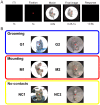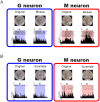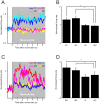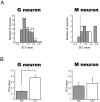Neuronal categorization and discrimination of social behaviors in primate prefrontal cortex
- PMID: 23285110
- PMCID: PMC3532303
- DOI: 10.1371/journal.pone.0052610
Neuronal categorization and discrimination of social behaviors in primate prefrontal cortex
Abstract
It has been implied that primates have an ability to categorize social behaviors between other individuals for the execution of adequate social-interactions. Since the lateral prefrontal cortex (LPFC) is involved in both the categorization and the processing of social information, the primate LPFC may be involved in the categorization of social behaviors. To test this hypothesis, we examined neuronal activity in the LPFC of monkeys during presentations of two types of movies of social behaviors (grooming, mounting) and movies of plural monkeys without any eye- or body-contacts between them (no-contacts movies). Although the monkeys were not required to categorize and discriminate the movies in this task, a subset of neurons sampled from the LPFC showed a significantly different activity during the presentation of a specific type of social behaviors in comparison with the others. These neurons categorized social behaviors at the population level and, at the individual neuron level, the majority of the neurons discriminated each movie within the same category of social behaviors. Our findings suggest that a fraction of LPFC neurons process categorical and discriminative information of social behaviors, thereby contributing to the adaptation to social environments.
Conflict of interest statement
Figures









Similar articles
-
Dynamic Axis-Tuned Cells in the Monkey Lateral Prefrontal Cortex during a Path-Planning Task.J Neurosci. 2020 Jan 2;40(1):203-219. doi: 10.1523/JNEUROSCI.2526-18.2019. Epub 2019 Nov 12. J Neurosci. 2020. PMID: 31719167 Free PMC article.
-
Functional significance of delay-period activity of primate prefrontal neurons in relation to spatial working memory and reward/omission-of-reward expectancy.Exp Brain Res. 2005 Oct;166(2):263-76. doi: 10.1007/s00221-005-2358-y. Epub 2005 Jul 21. Exp Brain Res. 2005. PMID: 16034567
-
Ensembles code for associative learning in the primate lateral prefrontal cortex.Cell Rep. 2023 May 30;42(5):112449. doi: 10.1016/j.celrep.2023.112449. Epub 2023 Apr 27. Cell Rep. 2023. PMID: 37119136
-
Integration of cognitive and motivational context information in the primate prefrontal cortex.Cereb Cortex. 2007 Sep;17 Suppl 1:i101-9. doi: 10.1093/cercor/bhm067. Cereb Cortex. 2007. PMID: 17725993 Review.
-
Integration of cognitive and motivational information in the primate lateral prefrontal cortex.Ann N Y Acad Sci. 2007 May;1104:89-107. doi: 10.1196/annals.1390.010. Epub 2007 Apr 7. Ann N Y Acad Sci. 2007. PMID: 17416923 Review.
Cited by
-
Levels of naturalism in social neuroscience research.iScience. 2021 Jun 12;24(7):102702. doi: 10.1016/j.isci.2021.102702. eCollection 2021 Jul 23. iScience. 2021. PMID: 34258547 Free PMC article. Review.
-
Neuronal mechanisms and circuits underlying repetitive behaviors in mouse models of autism spectrum disorder.Behav Brain Funct. 2016 Jan 20;12(1):3. doi: 10.1186/s12993-016-0087-y. Behav Brain Funct. 2016. PMID: 26790724 Free PMC article. Review.
-
Neural Coding for Action Execution and Action Observation in the Prefrontal Cortex and Its Role in the Organization of Socially Driven Behavior.Front Neurosci. 2017 Sep 7;11:492. doi: 10.3389/fnins.2017.00492. eCollection 2017. Front Neurosci. 2017. PMID: 28936159 Free PMC article. Review.
-
Pharmacological enhancement of memory or cognition in normal subjects.Front Syst Neurosci. 2014 May 20;8:90. doi: 10.3389/fnsys.2014.00090. eCollection 2014. Front Syst Neurosci. 2014. PMID: 24904313 Free PMC article. Review.
References
-
- Byrne RW, Whiten A (1988) Machiavellian Intelligence: Social Expertise and the Evolution of Intellect in Monkeys, Apes, and Humans. New York: Oxford University Press.
-
- Cheney DL, Seyfarth RM (1990) How Monkeys See the World: Inside the Mind of Another Species. Chicago: University of Chicago Press.
-
- Cheney DL, Seyfarth RM (2007) Baboon Metaphysics: The Evolution of a Social Mind. Chicago: University of Chicago Press.
-
- Kutsukake N, Hasegawa T (2005) Dominance turnover between an alpha and a beta male and dynamics of social relationships in Japanese macaques. Int J Primatol 26: 775–800.
-
- Perry S (1998) A case report of a male rank reversal in a group of wild white-faced capuchins (Cebus capucinus). Primates 39: 51–70.
Publication types
MeSH terms
LinkOut - more resources
Full Text Sources

